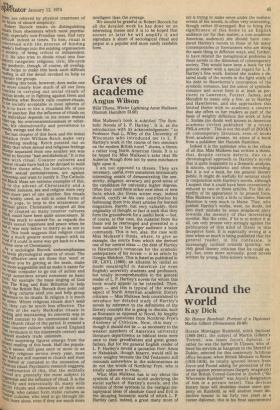The national health
William Sargant
Ritual in Industrial Society. A Sociologic analysis of ritualism in modern Engla% Robert Bocock. (George Allen and VIVI-.
£4.00).
This may or may not be a good time of tli,ee year to publish this book on ritual whest!rid have all had a stomachful of Christmas "ts, New Year ritual, and in an industrial socieis in temporary disarray at that. The book, ito{ claimed, will interest a very broad scoPeoy readers but, apart from sociologists, 01%1 may find it hard going. It is full of socioloroo ritual itself with profuse references to ece and bad past literature, giving the appearP,,, of perhaps being the basis of a universi`t'o thesis, and containing profuse references oci Freudian and other themes to bolster UP 8iy supposedly explain his sociological obserse tions. Many sociologists have yet to rea that much Freudian sexual subconsci°,st theory may turn out to be the bigg„10, psychological hoax of the century. Espenl'es, now that so many behaviour disturbancro, with supposedly Freudian sexual exPla
,t,i°ns, are relieved by physical treatment of 1 he brain of absurd simplicity.
Robert Bocock insists on distinguishing ' rituals from obsessions which most psychia,tri.sts, especially non-Freudian ones, find very uifficult indeed at times. To him, ritual is concerned with the process of binding DeoPle's feelings into the existing organisation °f society, of being critical or independent of it. He also tries to divide ritual into four distinct categories: religious, civic, life-cycle and aesthetic, though, of course, all overlap. What helps to make this book such difficult reading is all the detail invoked to help to seParate the groups. Reading this book, however, does make one see more clearly how much of all our lives consists in carrying out social rituals of various kinds, or in fighting against them and lil!oducing what Bocock calls counter-rituals. o be socially acceptable in most spheres of ufe is to have to live a ritualised life of one Lert or another. But the influence of rituals on ZY, individual depends on his innate mental t• te-up, his overconscientiousness or other • his obsessionality and prevalence to [ Inoods, swings and the like. The last chapter of this book and the initial llotation from William Reich make very !Iteresting reading. Reich pointed out so ' htlY that when sexual and religious feelings f come separated from one another sex was reed to become "bad and diabolical." It is the eaine with ritual. Counter cultures and t°unter rituals have had to be devised to weld ..gether those who, for instance, enjoy sreater sexual permissiveness, are against 1 censorship and want to justify it. The Catholic ti Black Mass are extreme examples of this. ri to the advent of Christianity and a 0rrned Judaism, sex and religion were very ' w.tich more part of one another. Sex rituals Te widely used, as still in some forms of . sqltric yoga, to help in the attainment of aPiritual grace. Christianity stopped all this nci so created so many counter cultures ich could have been quite unnecessary. St v7111 has much to answer for, as regards the CiArld's sexual happiness and peace when he bhaq it was only better to marry so as not to This book suggests that religion could a much greater social impact with its if it could in some way get back to a less 'Wine view of Christianity. this a sociologist Bocock underemphasises ree brain physiological aspects of ritual. The ehal,IY effective ones are those that 'send' or y'oirance you by getting at the brain, make 414 more suggestible and so make it easier for brain computer to go out of action and C'eept sometimes arrant nonsense as basic sraa tn: for example the mass singing of God ii4ve The King and Rule Britannia to help ths,stifY the British Raj. Bocock does point out 447! drug cultures send you and help group , eerence to its rituals. In religion it is much i e same. Where religious rituals don't send they can be much less effective. The I se'ecess of the early Methodist rituals in iiitaltiing and maintaining its converts was in tiorLed contrast to the unemotional and rast nal church ritual of the period. It created a tr,seble counter culture which saved England revolution in the nineteenth century and vstered modern trade unionism. ,1:,..orne surprising figures emerge from the tgent reading of this book. Half the popula04, it seems, still goes once or more to an th 'nary religious service every year, more 41,4eri half are still married in church and most N buried or cremated to the intonation of 11;11istian ritual. Psychiatric research suggests, 110 confirmation of this, that the mentally sy,1111a1 are generally the most subject to ibe6gesti0n and the influence of ritual. It is the ap„,11,tally and neurotically ill, many with qe`weial rituals and obsessions of their own toti'sing, who cannot form stable cultures as kunter cultures, who tend to go through life
e1 more alone, even if they are much more
intelligent than the average. We should be grateful to Robert Bocock for all the 'detailed work he has done on an interesting theme and it is to be hoped that sooner or later he will amplify it and reproduce it shorn of sociological ritual and jargon in a popular and more easily readable form.



































 Previous page
Previous page